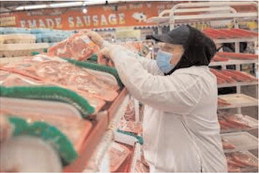Meat shortage expected to ease in days ahead

JONESBORO — The reopening of more than a dozen major meatpacking facilities across the country in recent days will have a significant impact on grocers’ meat supplies, a top state agriculture official said Friday.
Dr. John Anderson, head of the agricultural economics and agribusiness department of University of Arkansas System Division of Agriculture and the Dale Bumpers College of Agricultural Food and Life Sciences, said the supply issues are resolving, but it’s hard to predict when they will be fully resolved.
“I don’t think we’ll see long-term shortages,” Anderson said. “This is not a situation where we’re running out of product, and I think that’s what people fear … We’re not running out of product. We’ve had a temporary disruption here that’s made it difficult to get that product through the system and into retail.”
One local grocer said reports of a meat shortage have been exaggerated.
However, Bill Orr, owner of Bill’s Cost+Plus, said prices will swing back and forth as the industry adjusts to new regulations during the coronavirus pandemic.
While national retailers have imposed limits on meat purchases in recent weeks, Orr said he’s learned that “limiting doesn’t seem to slow the purchasing down. So, we just cut our meat, put it out there, and so far, we’ve had plenty, and we’ve still got plenty.”
Orr said the price of ground beef will likely be most affected by rising prices.
The fact that his stores hire their own butchers to cut and package their meats provides more flexibility compared to prepackaged meats at the national
Continued on Page 13 STATE NEWS (cont.)
chains.
The meatpacking plants were forced to close because of large outbreaks of COVID-19. The plants reopened after implementing the Centers for Disease Control and Prevention (CDC) and the Department of Labor’s Occupational Safety and Health Administration (OSHA) guidelines specifically created for the meat and poultry sector response to the COVID-19 pandemic.
The U.S. Department of Agriculture, in conjunction with the CDC and state and local health officials, have been working around the clock to ensure a safe and stable supply of protein is available for American consumers all while keeping employees safe, Agriculture Secretary Sonny Perdue said Friday in a news release.
Anderson said the processing plant disruptions created a severe bottleneck in the beef and pork supply chains. Downstream from that bottleneck, wholesale meat prices soared as customers faced smaller supplies of available product.
On the other hand, upstream from that bottleneck, livestock prices fell as market-ready supplies of animals continued to come to a market that no longer had enough capacity to handle them, he said.
“All of these reopenings, I think, are very significant,” Anderson said Thursday.
“Going back, especially, to the hog plant, the JBS hog plant in Sioux Falls, that was the big one. That was the one where everybody stepped back and said this could really bite. This could really constrain our ability to get animals processed in a timely manner, because that’s a really big plant.”
Anderson said the market had some buffer from immediate shortages because the plants had considerable amounts of product in cold storage.
Anderson and Orr said an estimated 20 percent reduction in supplies available to grocers forced some consumers to perhaps settle for lower-grade beef and pork cuts, but protein continued to be available.
At the same time, many consumers bought more chicken when beef and pork supplies were less attractive.



Share